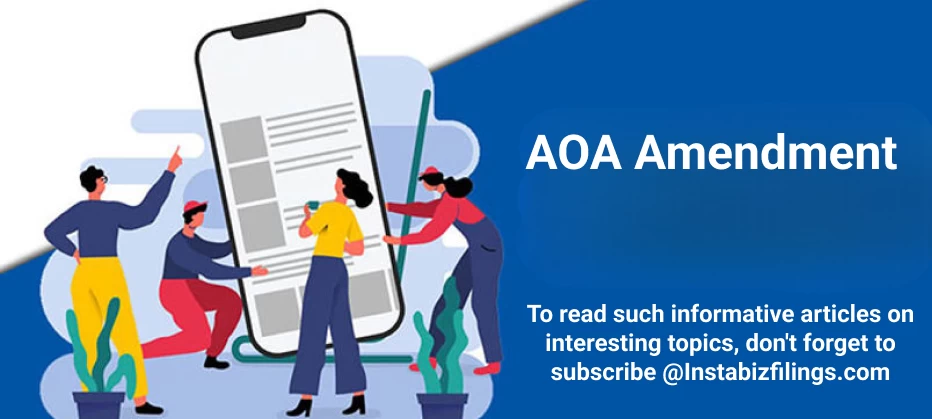
AOA Amendment
February 21, 2025 by Team Instabizfilings
A company relies on the Memorandum of Association (MOA) together with the Articles of Association (AOA) to establish its business structure while defining both internal management and external organizational goals. A company defines its outside activities and scope and relationship with external interests through the MOA but its AOA spells out the rules for managing internal activities including director appointments and meeting conduct.
Business expansion requires companies to modify these documents at different stages of their growth. Business objectives along with capital structure and internal governance processes serve as reasons to amend the MOA and AOA. The document explains in detailed fashion how to modify MOA and AOA documents.
What is MOA and AOA?
-
MOA (Memorandum of Association): The MOA defines the constitution and objectives of the company. It outlines:
- The name of the company.
- The location of the registered office.
- The main objectives of the company (business activities).
- The liability of members.
- The share capital and types of shares issued by the company.
-
AOA (Articles of Association): The AOA governs the internal workings and day-to-day operations of the company. It includes provisions such as:
- The conduct of company meetings.
- The rights and obligations of shareholders and directors.
- The procedure for appointment or removal of directors.
- Dividend distribution.
- Powers of the board of directors.
Why Do Companies Amend MOA and AOA?
There are several reasons why a company might amend its MOA and AOA:
-
Change in Business Objectives: A company may wish to expand, alter, or diversify its business activities, which requires amending the MOA.
-
Increase in Share Capital: If a company decides to increase its share capital, the Capital Clause in the MOA must be amended.
-
Change in Company Name: A company may decide to rebrand itself, which would require amending the Name Clause in the MOA.
-
Change in Registered Office: If the company moves its registered office, this change must be reflected in the MOA.
-
Internal Governance Changes: Alterations in the powers of the directors, procedures for meetings, or shareholder rights may necessitate changes in the AOA.
-
Compliance with New Laws: Regulatory or legal changes may require the amendment of the MOA and AOA to stay compliant with new statutory requirements.
Procedure for Amendment of MOA (Memorandum of Association)
The procedure for amending the MOA involves several steps:
- Board Meeting and Approval:
- The Board of Directors must convene a meeting and approve the proposed amendments to the MOA.
- A Board Resolution should be passed, stating the specific amendments to be made.
- Shareholders’ Approval:
- After the Board has approved the changes, the proposal must be presented to the shareholders at a General Meeting.
- A Special Resolution (which requires a two-thirds majority vote) must be passed by the shareholders to approve the amendments to the MOA.
-
Filing with the Registrar of Companies (ROC):
- Once the special resolution is passed, the company must file the amended MOA with the Register of Companies (ROC).
- The company must submit Form MGT-14, along with a copy of the special resolution, to the Register for approval.
-
Registrar’s Approval:
- The Registrar of Companies (ROC) will review the amendments and may ask for clarifications or additional documentation.
- If the amendments are in compliance with the law, the ROC will approve them and update the company’s records accordingly.
-
Incorporation of Changes:
- After the ROC approves the amendments, the company will receive a certificate of incorporation reflecting the changes.
- The company must ensure that the updated MOA is kept in its records and used for all future legal and business transactions.
Procedure for Amendment of AOA (Articles of Association)
Amending the AOA follows a similar process to the MOA amendment, but there are specific considerations related to the internal management of the company. Here is the step-by-step process for amending the AOA:
-
Board Meeting and Approval:
- The first step in the amendment process is for the Board of Directors to discuss and approve the proposed changes to the AOA.
- A Board Resolution should be passed to authorize the amendment.
-
Shareholder Approval:
- Once the Board has approved the changes, a General Meeting of shareholders must be held.
- A Special Resolution must be passed by the shareholders to amend the AOA. This typically requires a two-thirds majority vote.
- If the amendment involves altering a provision in the AOA that requires a specific type of resolution (e.g., modifying a restriction on share transfer), this should be carefully reviewed in the company’s existing AOA.
-
Filing with the Registrar of Companies (ROC):
- After the special resolution is passed, the amended AOA must be filed with the Registrar of Companies (ROC).
- Form MGT-14 should be submitted to the ROC for approval along with a copy of the special resolution passed by the shareholders.
-
Registrar’s Approval:
- The Registrar will review the proposed amendments and, if they are in compliance with legal provisions, will approve the changes.
- If there are any issues or discrepancies, the Registrar may request clarifications or additional information.
-
Incorporation of Changes:
- Once the Register of Companies approves the amendments, the updated AOA will be registered.
- The company will receive a certificate of incorporation reflecting the changes in the AOA, and the company must update its internal records accordingly.
Key Considerations When Amending MOA and AOA
-
Amendments to the MOA and AOA need to satisfy both the provisions of Companies Act 2013 and the relevant law framework of the jurisdiction. The modifications must follow all statutory guidelines that affect corporate governance standards along with business operations and regulatory requirements.
-
The company needs to perform a thorough analysis of operational effects before making changes to the MOA or AOA regarding how they affect business activities along with financial arrangements and legal requirements. Modifying Object Clause or Capital Clause requirements in particular causes significant impacts on stakeholders and investor interests.
-
The company must maintain and document every resolution made by board members and shareholders together with all Register of Companies submissions as part of standard legal workflow.
-
Corporate law expertise alongside Company Secretary supervision ensures the amendments meet every applicable legal criteria alongside company targets.
Conclusion
A company needs to modify its Articles of Association and Memorandum of Association to bring their legal frame into synchronization with changes in business objectives and governance model or financial arrangements. Both documents must undergo amendments whenever changes occur within the business activity segment or share capital organization or internal processes need revision.
Companies need to follow the correct procedure starting with board approval before getting shareholder resolution and Register of Companies filing while obtaining necessary approvals to stay law-abiding and continue functional operation. The MOA and AOA should face proper amendments to guarantee adaptations of business structures and governance frameworks when business requirements transform.
Disclaimer
The information provided in this blog is purely for general informational purposes only. While every effort has been made to ensure the accuracy, reliability and completeness of the content presented, we make no representations or warranties of any kind, express or implied, for the same.
We expressly disclaim any and all liability for any loss, damage or injury arising from or in connection with the use of or reliance on this information. This includes, but is not limited to, any direct, indirect, incidental, consequential or punitive damage.
Further, we reserve the right to make changes to the content at any time without prior notice. For specific advice tailored to your situation, we request you to get in touch with us.


